As an Amazon Associate I earn from qualifying purchases.
Not a pancake, nor really a dumpling, Chinese scallion pancakes are really something of a flatbread.
These are one of the highlights of my springtime, since I will often use wild onions instead of store bought scallions. Any green, oniony thing will work here.
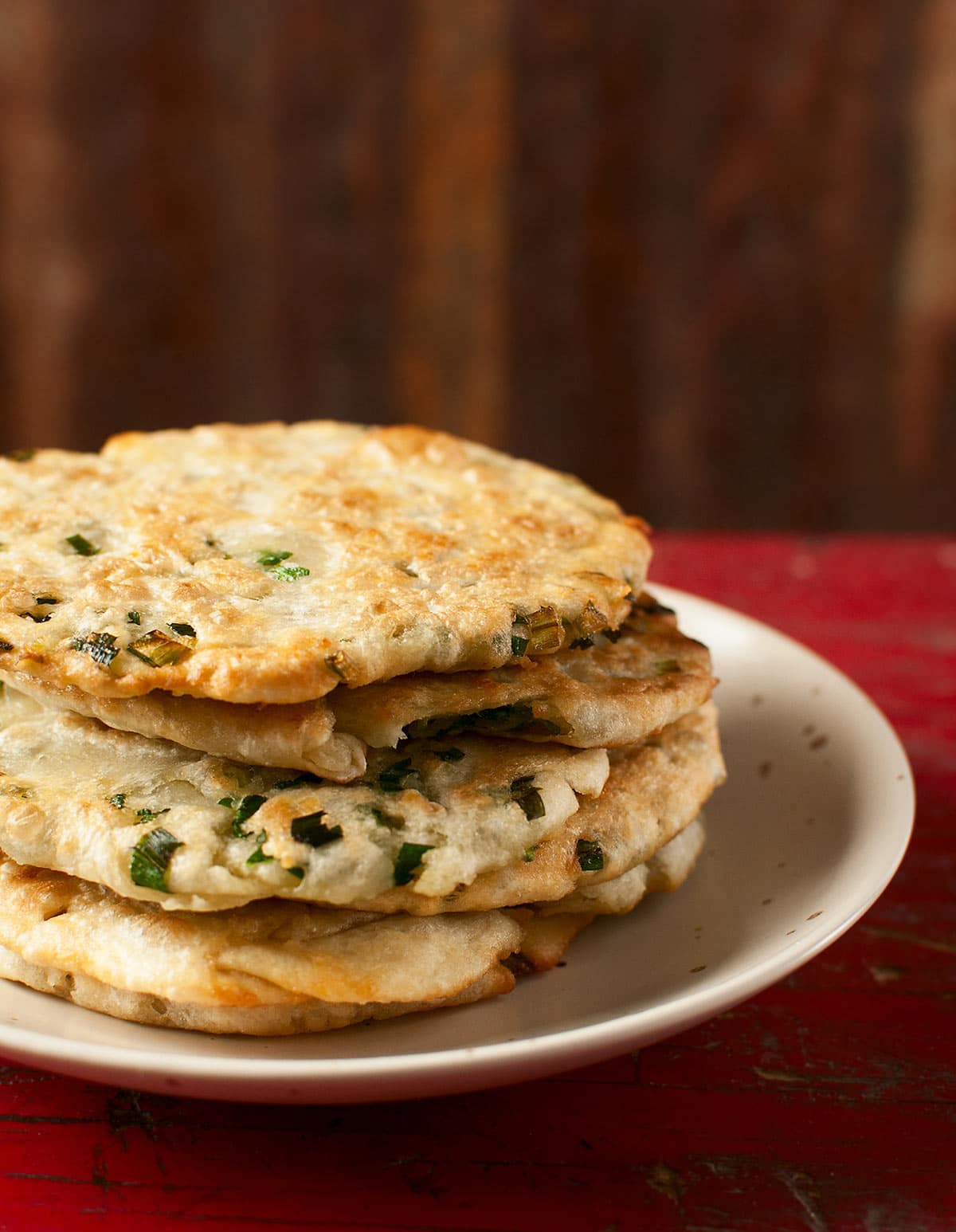
Long-time readers of this space know I have an obsession with alliums: onions, garlic leeks and such. Every spring I harvest huge numbers of our local wild onion, the tri-cornered leek. Mostly I use them as a substitute for garden variety green onions or scallions.
Here with scallion pancakes, the onion is the star, the main flavoring and textural element. It is a fantastic way to celebrate the ephemeral bonanza of spring.
Chinese scallion pancakes are, as you might be able to tell from the picture, not really pancakes. They’re flatbreads. Really, really good flatbreads. I’d never eaten them before I first made this recipe, more than a decade ago, but they’ve become a spring tradition at our house.
Eating one is not really like eating bread. Yes, they are kinda-sorta bready, but these pancakes are chewier, you get a little juicy crunch from the onions. and the aroma of sesame oil and onion is so wonderful it’ll make your eyes roll back in your head. Like my venison potstickers, this is one of those “Oops! I ate them all. Again.” kind of foods.
One tip on rolling out your scallion pancakes: Use a simple tortilla press, which makes flattening the pancakes quick and easy. You can also roll them out with a pin. But the cross cultural use of a tortilla press really does make things much easier.
You can vary the fat — lard and rendered chicken fat are a good options that are used in China — and you can add one or two additional flavor elements, such as ground Sichuan peppercorns.
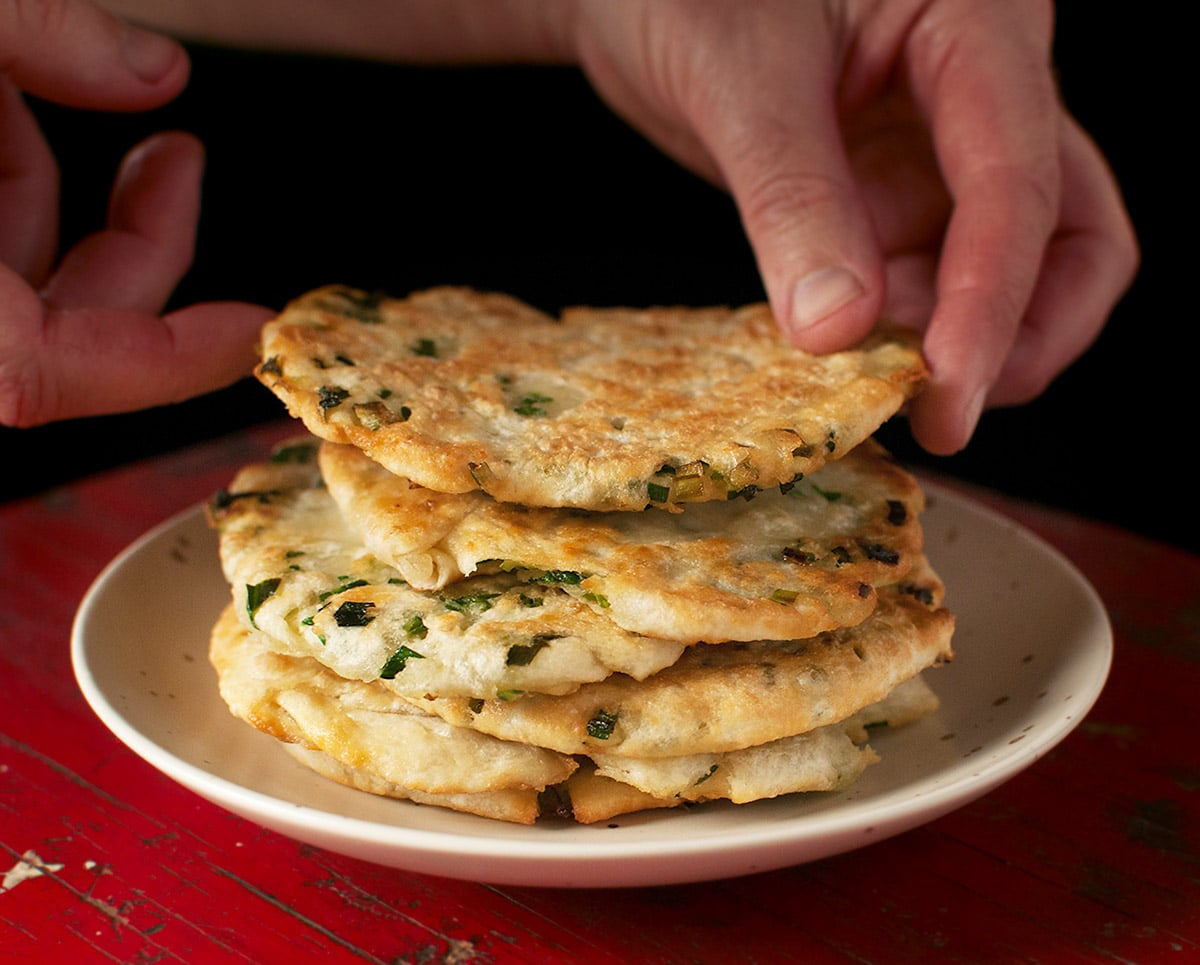
How to eat them? By themselves they are great, but they become sublime with a sweet-spicy dipping sauce. Think Sriracha with a spoonful of honey in it.
Scallion pancakes are also good cold as a trail snack, or something to bring to work or on a long drive.
If you want to make this as part of a larger Chinese meal, you can add dishes like fish stir fry or Chinese braised mushrooms. Another good accompaniment would be Chinese lettuce cups.
Scallion Pancakes
Ingredients
- 2 3/4 cups all-purpose flour
- 1 cup hot water
- 2 cups minced green onions, ramps, etc
- 1 tablespoon salt
- Sesame oil for brushing, about 2 to 3 tablespoons
- Peanut or other vegetable oil for frying
Instructions
- Put the flour in a large bowl and mix in the salt. Make a well in the center. Bring the water to a boil, then turn off the heat. When the water stops bubbling, pour it into the well in the flour. Stir together with a fork until you get a shaggy mass. Wipe the goopy flour off the fork and knead the mass into an elastic dough, which should take about 3 to 5 minutes. Put the dough into a plastic bag or wrap it in plastic wrap and let the dough sit for 30 minutes to 2 hours.
- Take the dough out and cut it into four pieces. Put three of them back into the plastic bag. For a work surface, I use a baking sheet flipped over that I've lightly oiled with vegetable oil. Roll out the piece of dough into a roughly rectangular shape; it doesn't need to be precise.
- Paint the dough with the sesame oil, then sprinkle with about a half teaspoon of salt. Sprinkle minced scallions over the dough generously, leaving about 1/2 inch free space on all sides of the dough.
- Roll the dough into a tight log starting from the longer side of the rectangle. Slice the log in half and pinch close the ends of the log to keep the scallions from spilling out. Take one half of the log and roll it tightly into a snail. Flatten the snail with the palm of your hand.
- Cut up a Ziploc bag or somesuch into large plastic squares that will cover your tortilla press. Place the flattened snail on one piece of plastic, cover it with another. Squash the dough with the tortilla press, or roll it out with a rolling pin to a thickness of 1/8 to 1/4 quarter of an inch.
- Now you need to fry the pancakes in a little hot oil. I fry and press as I go, keeping the finished pancakes in a tortilla warmer lined with paper towels. You could also put them on a baking sheet in an oven set to 200°F. But if you are a beginner, roll out all your pancakes first.
- I fry the pancakes in a large sauté pan with about a tablespoon of vegetable oil. I prefer peanut oil because it's used a lot in Chinese cooking. Lard is another good choice. Get the oil hot before you drop the pancake in and cook for about 2 minutes per side, just until you get a little browning on them. Serve by themselves, with soy sauce or with a sweet-spicy dipping sauce.
Notes
Nutrition
Nutrition information is automatically calculated, so should only be used as an approximation.
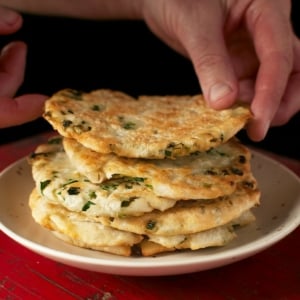
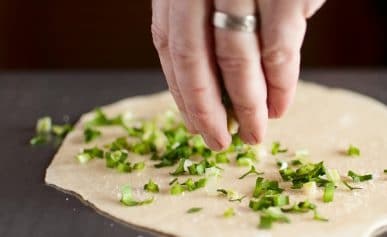
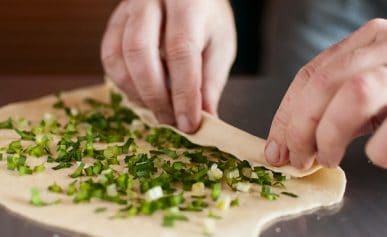
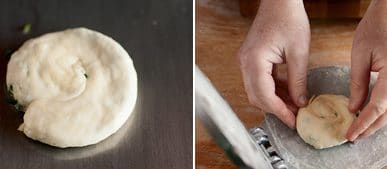
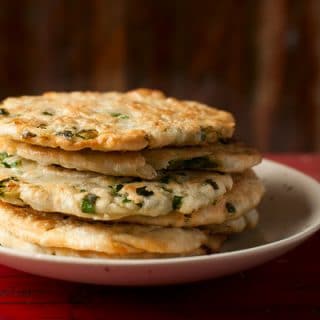
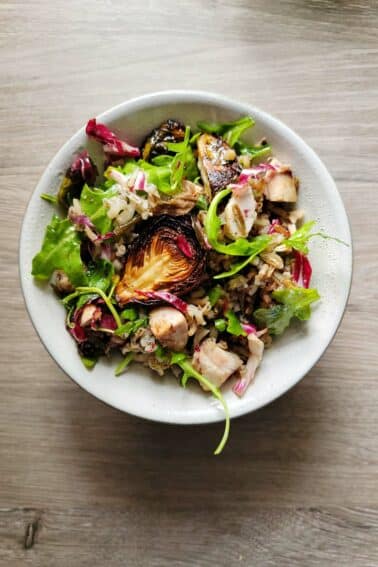
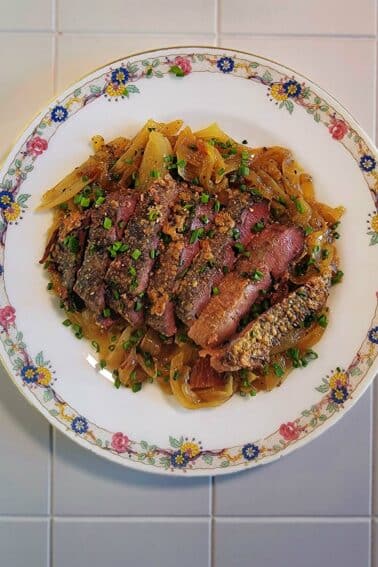
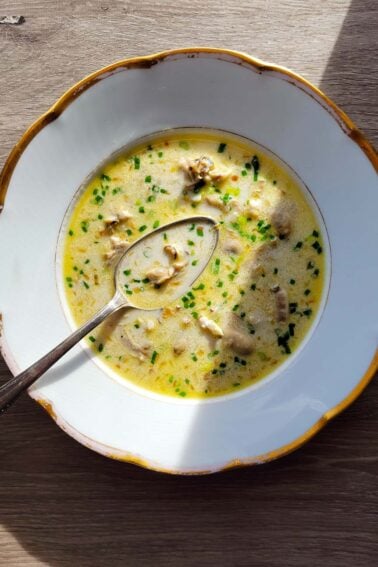
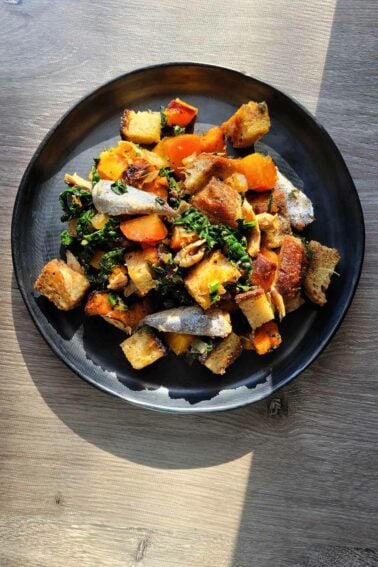
Absolutely delicious. I used ramps. I preferred these on the tinner side. Nice and crispy
Made these recently with some of the wild onions emerging locally, and they’re delicious. I’m also glad to see that these only call for the tops of ramps/wild leeks, as other commenters noted! Responsible foraging ensures these plants stick around for seasons to come.
So much easier than I thought it would be to make and way tastier than anticipated. Delicious
There is also another Taiwanese version that involves mixing lard and scallions before putting it on the dough, twisting the dough like you are wringing it to give it super flakiness. Pan fry an egg, pressed the cooked pancake into the egg before it is set. Roll it up and serve with hot sauce. Yum!
And yes, there are a million ways to make a scallion pancake, thanks for posting! Your post just remind me to render lard from the fat I have.
Cathy: Oooh. That sounds awesome!
Can these be made with almond flour for people doing low carb or keto?
Eddy: I doubt it, but if you give it a go and it works, definitely let me know.
Well Hank,
How about the recipe for the Venison pot sticker!
A perfect compliment to this..
R.P.: You mean this recipe for venison potstickers? https://honest-food.net/venison-potstickers-recipe/
I must try these pancakes. Do you know what the pirates favorite allium is? Garrrrlic
Hi Hank – thanks for this recipe – I look forward to trying it, if spring ever arrives to New England (I still have a foot of snow in my yard in Arlington, MA, on this, the second day of Spring).
Anyway – I would like to take note that this recipe only calls for the “upper” portion of the wild onion/leek plants (not the bulb), which I was glad to see.
Here in Massachusetts, I’ve observed first-hand the damage to wild leek (aka ramp) patches and the sensitive, “rich woods” habitats they grow in, primarily due to large-scale, irresponsible digging up of ramps for commercial purposes.
Here are a couple links that go into more details about this:
https://boston.eater.com/archives/2012/03/29/post-12.php
https://www.watershedpost.com/2011/ramps-too-trendy
But here’s the good news – you don’t have to dig up a ramp to enjoy its fine flavor. As you know, the leaves are delicious on their own and can be used many ways, including this “wild scallion” pancake recipe.
I encourage this sustainable harvesting method for ramps: pick only one leaf/plant, leave the remaining leaf or leaves attached to the bulb, and leave the bulb in the ground. That way you (and others) can return to the same ramp patch year after year without harming it or its habitat.
So, Hank, thanks for providing a recipe calling for ramps that uses the leaves + stems only, that is compatible with my suggested “no dig” method of sustainable harvesting.
Hank,
You REALLY need to teach a class on how to pick/where to find wild edibles. Rapini, I know. Barba di prete, I know. Funghi, I know. Would like to learn a few others.
-Lou
Yum, these look amazing. The pictures are gorgeous.
My wife, Joungmin, says she’d like to have the opportunity to teach you how to make a Korean version, one of which is haemul pajeon or seafood “pancake;” featuring squid, mussels, scallions, and spicy green gochu peppers!
These look fab. I can’t wait for wild garlic to appear in the woods, would love to try it in these. I’m wondering if my Egyptian walking onions, a perennial veggie which are just sending out lots of spring onion like shoots, might be good in these too?
A very different pancake, but one which makes the green onion even more of a star, is the Korean pa-jeon. This is an eggy pancake with long lengths of scallions or chives and, optionally, seafood. It’s also much quicker to make. I highly recommend it!
Great recipe. We did this two years ago with ramps leaves (Allium tricoccum), using the Serious Eats method. I have never eaten Chinese-style onion pancakes before, but we make these often in the spring now. They definitely do not last long!
https://the3foragers.blogspot.com/2011/04/ramps-pancakes-chinese-style.html
Awesome…I love scallion pancakes…have you checked out Serious Eats method from Kenji? Very similar to yours, but he does a few turns with the dough, and only sprinkles on the scallions after 2nd…gives it more layers for the laminate dough…I’ve tried it, and it comes out great
https://www.seriouseats.com/recipes/2011/04/extra-flaky-scallion-pancakes-recipe.html
My mother (who is from Beijing) always makes this for me whenever I come home to visit. She is an expert. Your method is super authentic, bravo. But might I suggest two improvements?
First, we have found that using a wetter the dough makes the final result a lot better. It fries more uniformly and comes out flaking for some reason, although it does makes it more difficult to work with. You also have to work faster, because otherwise the layers from the rolling and flattening start to mush together faster. But I think it’s worth it.
The other thing we usually do when making this is to fry the onion very briefly in hot oil first, the mix it with the sesame oil and salt to format a sort of paste. That way the onion becomes soft and runs less a chance of puncturing the dough layers when you roll and flatten it. Also sometimes we use a 50/50 blend of red onion and green onion.
Anyways, that’s just how my family does. Great, authentic recipe though! Thanks.